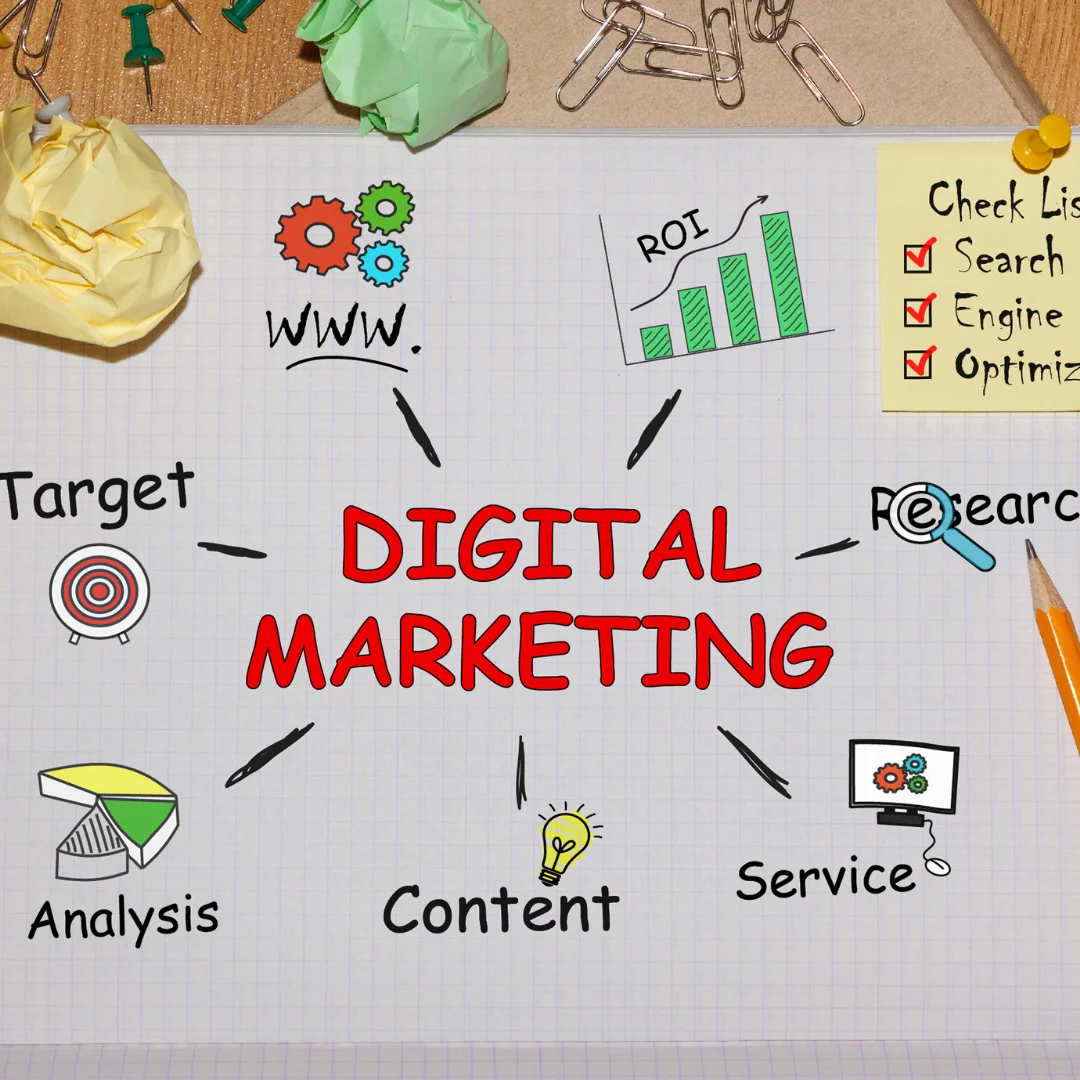Market analysis might not be the flashiest part of the B2B tech world, but it’s the secret sauce that separates the titans from the mere mortals. It’s what keeps marketers ahead of the curve—analyzing trends, understanding competitors, and predicting customer needs before they even know they have them.
And here’s the kicker: AI is revolutionizing market analysis. It’s like giving your marketing team superpowers—minus the capes, unfortunately. In this guide, we’ll unveil the Top 6 AI Tools for Market Analysis for B2B Tech in 2025, each capable of turning your data into actionable insights (and maybe a little magic).
So buckle up, because these tools are about to make your competitors wish they’d stayed in 2010.
The Role of AI in Modern Market Analysis

Let’s face it: market analysis used to be the domain of spreadsheets and caffeine-fueled late nights. But then AI came along, and suddenly, all those hours spent manually compiling data looked like something out of the Stone Age.
Here’s the deal: AI in market analysis doesn’t just make things faster—it makes them better. Imagine having a Sherlock Holmes in your marketing department, but instead of deducing murderers, it’s predicting customer trends, competitor moves, and market shifts.
How AI Is Transforming Market Analysis
- Data Crunching at Warp Speed
Humans are great at many things—making memes, inventing excuses, and binge-watching shows—but crunching terabytes of data in real time? Not so much. AI tools can sift through colossal amounts of data, identify patterns, and spit out actionable insights before your coffee gets cold.
Example: Predictive analytics tools powered by AI can analyze customer behavior and predict which leads are most likely to convert. Forget guesswork; this is data-driven magic. - Spotting Trends Like a Hawk
Remember when spotting market trends meant relying on gut feelings and outdated reports? AI changes that. It monitors social media, news, and industry forums to detect emerging trends long before they hit the mainstream.
Case in Point: A B2B tech company used AI to identify a growing demand for remote work solutions back in early 2020. By pivoting their strategy, they captured a significant market share while competitors scrambled to keep up. - Hyper-Personalized Insights
Blanket marketing strategies are so last decade. AI allows you to segment your audience with laser precision, tailoring campaigns to individual preferences and behaviors. It’s like whispering sweet nothings into your customers’ ears—except it’s data, not cheesy pickup lines.
The Challenges of Integrating AI
Let’s not sugarcoat it: bringing AI into your workflow can feel like teaching a cat to fetch. Here are the hurdles:
- Data Privacy Concerns: AI thrives on data, but consumers are understandably wary of how their information is used. Balancing the need for insights with ethical considerations is a tightrope act.
- The Learning Curve: Getting your team to trust AI can be like convincing your grandma that Netflix isn’t out to steal her identity. Training and adaptation take time.
- The “Job-Stealer” Debate: AI doesn’t replace marketers; it enhances them. But try explaining that to someone who just saw an algorithm do in minutes what used to take them days.
How to Make AI Your Best Friend
- Start Small: Don’t dive into the deep end of the AI pool just yet. Begin with tools that solve specific problems, like automating customer segmentation or improving lead scoring.
- Educate Your Team: The more your team understands AI, the less they’ll fear it. Plus, they’ll be better equipped to use it effectively.
- Iterate and Improve: AI isn’t a “set it and forget it” solution. Regularly review its performance, tweak its parameters, and keep an eye on emerging technologies.
In short, AI is the ultimate ally in modern market analysis—provided you’re ready to embrace its quirks (and maybe a little chaos).
Why You Need a Formal AI Strategy for Competitive Advantage

Picture this: you’re in a gladiator arena, armed with…a spoon. That’s what running a business without an AI strategy looks like in today’s hyper-competitive landscape. Sure, you might land a few lucky hits, but you’re mostly just flailing while your competitors wield swords of data-driven precision.
The Power of a Structured AI Strategy
AI isn’t a silver bullet—it’s a toolkit. But without a strategy, it’s like handing that toolkit to someone with no idea how to use a wrench. A formal AI strategy ensures you’re not just using AI—you’re leveraging it to dominate your market.
Key Benefits of a Formal AI Strategy
- Staying Ahead of the Curve
Markets shift faster than TikTok trends, and businesses that can’t keep up get left behind. A solid AI strategy helps you anticipate changes, adapt quickly, and capitalize on opportunities before your competitors even know they exist. - Productivity on Steroids
AI automates the boring stuff—data entry, report generation, and lead scoring—freeing your team to focus on high-value tasks like strategy and creative thinking. It’s like hiring an army of interns who never complain. - Enhanced Decision-Making
Decisions backed by data are always better than gut instincts. AI provides insights that are not only accurate but also actionable, helping you make smarter choices faster.
Real-Life Success Stories
- Company X: By integrating AI into their lead scoring process, they increased their conversion rates by 40%. How? AI identified patterns in customer behavior that human analysts had missed.
- Company Y: Used AI to optimize their content strategy, resulting in a 50% increase in organic traffic. The secret? AI-driven keyword research and trend analysis.
Pro Tips for Building Your AI Strategy
- Define Clear Objectives: What do you want AI to achieve? Whether it’s improving customer retention or streamlining operations, having clear goals is crucial.
- Choose the Right Tools: Not all AI tools are created equal. Research thoroughly and select tools that align with your business needs.
- Train Your Team: AI is only as good as the people using it. Invest in training to ensure your team can maximize its potential.
- Monitor and Adjust: An AI strategy isn’t static. Regularly review your results, identify areas for improvement, and adapt to new technologies as they emerge.
The Bottom Line
AI isn’t just the future—it’s the present. And without a formal strategy, you’re essentially bringing a spoon to a sword fight. So sharpen your tools, define your goals, and get ready to dominate the market analysis game like the gladiator you were born to be.
1. StealthGPT – The Undetected Writing Tool for Content Creation

AI writing tools are a dime a dozen these days, but StealthGPT isn’t just another cog in the content machine. It’s the James Bond of AI writing tools—stealthy, efficient, and always dressed for success (metaphorically speaking).
What Sets StealthGPT Apart?
Unlike other tools that churn out robotic prose, StealthGPT creates content so human-like, you’d swear it had a soul (spoiler: it doesn’t). Here’s what makes it a standout for market analysis in the B2B tech world:
- High-Quality, Human-Sounding Content
Say goodbye to clunky, AI-generated sentences that scream, “I was written by a machine!” StealthGPT’s algorithms are designed to mimic natural language, producing content that’s polished, engaging, and as human as it gets without needing coffee breaks. - Tailored for B2B Tech
Writing for B2B tech can feel like translating ancient texts—full of jargon, acronyms, and complexity. StealthGPT cuts through the noise, generating content that’s not only accurate but also digestible for your target audience. - Versatility Across Formats
Blogs, whitepapers, case studies—you name it, StealthGPT can handle it. And it’s fast. Need a 2,000-word blog post by tomorrow? Consider it done. Want to whip up a case study on how your product revolutionized market analysis for a Fortune 500 company? StealthGPT’s got your back.
Why B2B Tech Marketers Love It
StealthGPT isn’t just about speed or convenience—it’s about delivering consistent, high-quality material that keeps your audience hooked. Think of it as your secret weapon for meeting tight deadlines without breaking a sweat.
Example Use Case:
A B2B tech startup used StealthGPT to produce a series of blog posts highlighting their innovative approach to market analysis. The result? A 150% increase in website traffic within three months. Not bad for a tool that works silently in the background, right?
2. Surfer SEO – Optimizing Your Way to Higher Search Engine Rankings
SEO can feel like trying to solve a Rubik’s Cube in the dark. You know there’s a method to the madness, but it’s hard to pin down. Enter Surfer SEO—the GPS for your SEO journey.
The Magic Behind Surfer SEO
When it comes to market analysis, visibility is everything. You can have the most insightful content on the planet, but if it’s buried on page 12 of Google, no one’s finding it. Surfer SEO ensures your content gets the attention it deserves.
- Actionable Insights Galore
Surfer SEO isn’t just another analytics tool—it’s like having an SEO coach whispering tips in your ear. It provides detailed recommendations on:- Keyword Density: Ensures you’re hitting the sweet spot, avoiding both keyword stuffing and underutilization.
- Readability: No one likes reading walls of text. Surfer SEO helps you break down complex ideas into digestible content.
- Content Structure: Guides you on headings, subheadings, and paragraph length to keep readers engaged.
- Data-Driven Optimization
Surfer SEO analyzes top-ranking pages and compares them to your content. It’s like spying on your competitors—legally. You’ll know exactly what works in your niche and how to replicate (or surpass) their success. - Integration Made Easy
Whether you’re using WordPress, Google Docs, or a random notepad app, Surfer SEO integrates seamlessly, ensuring you can optimize as you write.
Why It’s a Must-Have for Market Analysis
If you want your market analysis content to reach decision-makers in B2B tech, you need to optimize it for search engines. Surfer SEO takes the guesswork out of SEO, giving you a clear roadmap to higher rankings.
Example Use Case:
A marketing agency used Surfer SEO to optimize their client’s blog posts on market analysis trends. The result? A 40% increase in organic traffic and a 25% boost in lead generation within six months.
3. Jasper AI – The Versatile Copywriting Tool for All Formats

If StealthGPT is the secret agent of AI writing tools, Jasper AI is the Swiss Army knife (okay, not using that term, but you get the idea). It’s versatile, reliable, and perfect for crafting compelling copy across every platform imaginable.
Why Jasper Is a Game-Changer
Good copy is the backbone of any marketing campaign, especially in the B2B tech world. Jasper AI ensures your messaging hits the mark every time.
- Adaptability Across Formats
Whether you need snappy ad copy, persuasive email campaigns, or engaging social media posts, Jasper delivers. It’s like having a team of copywriters on call—minus the coffee-induced meltdowns. - Personalized Brand Voice
Jasper doesn’t just spit out generic content. It learns your brand voice, adapting its tone and style to match your unique personality. This is especially crucial for B2B tech companies, where trust and credibility are everything. - AI That Drives Conversions
Jasper isn’t just about sounding good—it’s about getting results. By crafting copy that speaks directly to your audience’s pain points, it boosts engagement and drives conversions like a pro.
Why B2B Tech Marketers Swear By It
When time is of the essence (read: always), Jasper AI is a lifesaver. Need to launch a multi-channel campaign next week? Jasper can generate ads, emails, and blog posts faster than you can say “workflow efficiency.”
Example Use Case:
A B2B tech company revamped their email marketing strategy using Jasper AI. The result? A 30% increase in open rates and a 20% bump in click-through rates. The secret? Personalized, engaging copy that resonated with their audience.
4. Notion AI – Boosting Team Productivity with Workspace Integration
If AI tools were superheroes, Notion AI would be the one wearing a sleek utility belt packed with gadgets. It’s not just about managing projects; it’s about turning your scattered team into a synchronized, productivity-churning machine. And the best part? It does all this while fitting neatly into your existing workflows, like the missing puzzle piece you didn’t know you needed.
Why Notion AI Is a Game-Changer for Market Analysis
Market analysis isn’t just about numbers—it’s about organizing those numbers, dissecting their meaning, and presenting them in a way that makes you look like a genius in front of your boss. That’s where Notion AI shines.
- Seamless Workflow Integration
Notion AI doesn’t try to reinvent the wheel; it just makes it spin smoother. Whether your team lives in spreadsheets, Slack, or email chains (ugh), Notion AI slips right in, connecting everything into a single, cohesive workspace. It’s like giving your chaotic workflows a much-needed therapy session. - Enhanced Collaboration and Knowledge Sharing
You know that “Where’s the report?” email thread that never seems to die? Notion AI eliminates that by centralizing all your documents, insights, and ideas in one place. Teams can brainstorm, annotate, and analyze market trends together without the dreaded “version control” nightmare. - Customizable Templates for Market Analysis
Need a SWOT analysis template? A competitor benchmarking dashboard? Notion AI has you covered. It offers ready-to-use templates that can be tailored to fit your specific needs, saving hours of setup time. - Automated Insights and Suggestions
Notion AI doesn’t just store information—it actively helps you organize and interpret it. From summarizing lengthy reports to suggesting next steps based on your data, it acts like a virtual project manager who never asks for a coffee break.
Example Use Case:
A mid-sized B2B tech firm used Notion AI to streamline their quarterly market analysis process. By centralizing data from multiple departments and automating repetitive tasks, they cut their analysis time in half. The result? More time spent strategizing and less time wrangling spreadsheets.
5. LALAL.AI – Enhancing Audio Quality with Background Noise Removal
Ever been on a webinar where the speaker’s dog contributes more to the conversation than they do? Enter LALAL.AI, the unsung hero of audio clarity.
Features That Save the Day:
- Noise Removal
Say goodbye to wind tunnel sounds, crying babies, and that oddly persistent hum in the background. LALAL.AI uses advanced algorithms to isolate and enhance the speaker’s voice, ensuring your message isn’t drowned out by chaos. - Perfect for Various Content Formats
Whether you’re producing a podcast, hosting a webinar, or creating video content, LALAL.AI ensures your audio quality matches your expertise. - User-Friendly Interface
You don’t need to be an audio engineer to use LALAL.AI. Upload your file, let the AI work its magic, and download a polished version—all in a few clicks.
6. Brand24 – Monitoring Your Brand’s Online Reputation with Media Monitoring
Your online reputation isn’t just a vanity metric—it’s a business-critical asset. Brand24 ensures you’re always in the loop about what people are saying, whether it’s praise, complaints, or the occasional troll.
How It Works:
- Real-Time Brand Mentions
Brand24 scours social media, blogs, forums, and news sites for mentions of your brand. It’s like having a personal investigator who doesn’t sleep. - Sentiment Analysis
Not all mentions are created equal. Brand24 uses sentiment analysis to categorize feedback as positive, negative, or neutral, helping you prioritize your response strategy. - Crisis Management
Spot a brewing PR storm before it goes viral. Brand24’s alerts let you jump into action, addressing issues before they escalate.
Why It’s Crucial for Market Analysis:
Understanding how your brand is perceived is key to identifying market trends and customer needs. Brand24 provides the context behind the numbers, giving you a more holistic view of your market position.
Example Use Case:
A SaaS company used Brand24 to monitor customer feedback during a product launch. By addressing negative comments in real time, they turned potential detractors into loyal advocates—and avoided a PR disaster.





